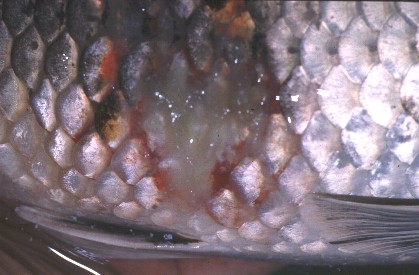Case details
6th April 2000: Client phoned to say that one koi was laying on the bottom, not eating and was generally lethargic. The fish had been like this for several weeks but kept rallying around – could I tell him what the problem was? Lacking the confidence of many in the aquatic trade I said no – at least not without seeing the fish!
Bacterial Ulcer |
|
 |
Large bacterial ulcer on koi with secondary Saprolegnia fungus infection – |
|
photo: Frank Prince-Iles |
|
It was a small, shallow circular pond holding 2,200 litres (500 gal UK) of water with goldfish and two koi. Everything looked fine. The koi causing concern had been purchased at Christmas.
Water testing
Everything OK
Fish examination
The koi was, as his owner said, laying on the bottom. However, there was a mass of Saprolegnia fungus on one side, a small area of fungus on the other side surrounded by inflammation and the caudal (tail fin) was eroded. A skin scrape showed a higher than normal number of skin flukes (Gyrodactylus). The other koi also had several skin flukes.
When we took the fish out of the water, the affected area was larger than first thought. The main area of the lesion was badly infected with a heavy growth of secondary fungus. There was extensive inflammation around the lesion and an area of raised scales to the rear of the ulcer. There was no skin covering the raised scales.
The infection may have been caused by the presence of skin flukes or it may have been stress related. A significant factor was the koi being purchased and put into a pond at the end of December – more so with the relatively mild temperatures at the time. It is quite probable that the combination of flukes, the stress of handling and transport together with water temperatures around 10oC (high enough for parasites but not for fish immune systems) was sufficient to start a slow but progressive deterioration.
It was my opinion that given the severity of the infection that the chances of survival were slim – probably between 20 – 50%
Treatment plan
06/04/00 The affected areas were thoroughly debrided and cleaned using povodine-iodine and covered with a water-proof paste (Orabase) The koi was given an antibiotic injection (enrofloxacin) and put in a treatment tank containing salt (3g/litre) and malachite green (0.2mg/litre)
07/04/00 The same treatment repeated
08/04/00 Saprolegnia had re-established itself in the ulcer, which was now covered again in a fluffy white coat. The lesion was this time cleaned with strong malachite green solution and sealed with paste. The tank re-dosed with malachite. Unless the fungus can be eradicated the ulcer will get worse rather than better
09/04/00 Fish removed from the hospital tank and sedated. The wound is still clean and free of fungus. A third antibiotic injection is given. The ulcer is lightly swabbed with povodine-iodine and dressed.
11/04/00: The fish’s condition deteriorated overnight – it was laying on its side and breathing heavily – it was euthanased to spare any further suffering. No post mortem was carried out.
Summary
Clearly, the customers description of the problem was inadequate and had I ventured a telephone diagnosis (a guess) I would have got it wrong!
As is so often the case, the situation was a lot worse when the fish was examined out of the water. My guess is that initially there was possibly a small lesion or perhaps a raised scale which could have been topically treated. By just “leaving the fish to get better” – this simple problem has progressed to a life-threatening situation that is going to be time-consuming and expensive to treat – with no guarantee that the fish will survive.
Buying fish in winter is a bad idea because of depressed immune systems and cold water temperatures
The fish died unnecessarily because it had remained untreated for so long while the problem got worse.

